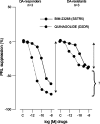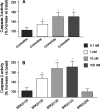Future treatment strategies of aggressive pituitary tumors
- PMID: 19003539
- PMCID: PMC2712619
- DOI: 10.1007/s11102-008-0154-y
Future treatment strategies of aggressive pituitary tumors
Abstract
While surgery remains the first-line treatment of most aggressive pituitary adenomas, medical therapy is important as second-line or adjunctive therapy in a large proportion of patients. Dopamine agonists (DAs) are the best treatment for prolactinomas, but when DAs are not tolerated, new somatostatin receptor subtype 5 (SSTR(5)) inhibitors may offer an alternative in the future. Unfortunately, these are unlikely to be effective in DA-resistant prolactinomas. In acromegaly, the existing somatostatin analogs, octreotide and lanreotide, will remain the medical treatment of choice for the foreseeable future. There is an urgent need for medical therapies in Cushing's disease, and the SSTR(5) analogs could offer an effective treatment in a proportion of patients within the next few years. Finally, the medical management options for non-functioning pituitary adenomas are also very limited, and a new chimeric agent with activity towards dopamine receptors, SSTR(5) and SSTR(2) may help reduce adenoma recurrence in the future.
Figures



References
-
- {'text': '', 'ref_index': 1, 'ids': [{'type': 'DOI', 'value': '10.1210/jc.84.9.3268', 'is_inner': False, 'url': 'https://doi.org/10.1210/jc.84.9.3268'}, {'type': 'PubMed', 'value': '10487698', 'is_inner': True, 'url': 'https://pubmed.ncbi.nlm.nih.gov/10487698/'}]}
- Jaquet P, Ouafik L, Saveanu A et al (1999) Quantitative and functional expression of somatostatin receptor subtypes in human prolactinomas. J Clin Endocrinol Metab 84(9):3268–3276. doi:10.1210/jc.84.9.3268 - PubMed
-
- {'text': '', 'ref_index': 1, 'ids': [{'type': 'DOI', 'value': '10.1210/jc.2003-031344', 'is_inner': False, 'url': 'https://doi.org/10.1210/jc.2003-031344'}, {'type': 'PubMed', 'value': '15070915', 'is_inner': True, 'url': 'https://pubmed.ncbi.nlm.nih.gov/15070915/'}]}
- Hofland LJ, van der Hoek J, van Koetsveld PM et al (2004) The novel somatostatin analog SOM230 is a potent inhibitor of hormone release by growth hormone- and prolactin-secreting pituitary adenomas in vitro. J Clin Endocrinol Metab 89(4):1577–1585. doi:10.1210/jc.2003-031344 - PubMed
-
- {'text': '', 'ref_index': 1, 'ids': [{'type': 'DOI', 'value': '10.1210/jc.83.9.3308', 'is_inner': False, 'url': 'https://doi.org/10.1210/jc.83.9.3308'}, {'type': 'PubMed', 'value': '9745446', 'is_inner': True, 'url': 'https://pubmed.ncbi.nlm.nih.gov/9745446/'}]}
- Chaidarun SS, Swearingen B, Alexander JM (1998) Differential expression of estrogen receptor-beta (ER beta) in human pituitary tumors: functional interactions with ER alpha and a tumor-specific splice variant. J Clin Endocrinol Metab 83(9):3308–3315. doi:10.1210/jc.83.9.3308 - PubMed
-
- {'text': '', 'ref_index': 1, 'ids': [{'type': 'DOI', 'value': '10.1023/A:1009903603495', 'is_inner': False, 'url': 'https://doi.org/10.1023/a:1009903603495'}, {'type': 'PubMed', 'value': '11081186', 'is_inner': True, 'url': 'https://pubmed.ncbi.nlm.nih.gov/11081186/'}]}
- Kaptain GJ, Simmons NE, Alden TD, Lopes MB, Vance ML, Laws ER (1999) Estrogen receptors in prolactinomas: a clinico-pathological study. Pituitary 1(2):91–98. doi:10.1023/A:1009903603495 - PubMed
-
- {'text': '', 'ref_index': 1, 'ids': [{'type': 'DOI', 'value': '10.1210/er.2005-9998', 'is_inner': False, 'url': 'https://doi.org/10.1210/er.2005-9998'}, {'type': 'PubMed', 'value': '16705142', 'is_inner': True, 'url': 'https://pubmed.ncbi.nlm.nih.gov/16705142/'}]}
- Gillam MP, Molitch ME, Lombardi G, Colao A (2006) Advances in the treatment of prolactinomas. Endocr Rev 27(5):485–534. doi:10.1210/er.2005-9998 - PubMed
Publication types
MeSH terms
Substances
LinkOut - more resources
Full Text Sources
Other Literature Sources
Medical

